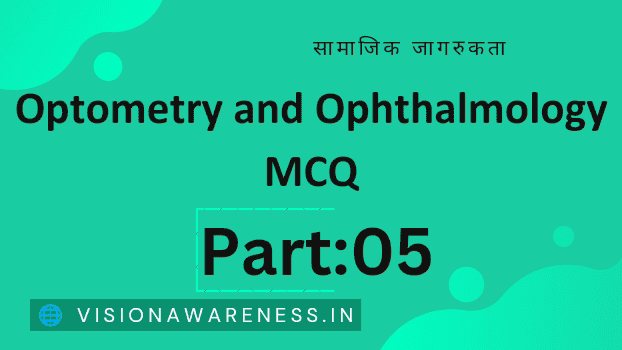01. Lagophthalmos can occur in all of the following except;
- a. 7th cranial nerve paralysis
- b. 5th cranial nerve paralysis
- c. Thyrotoxic exophthalmos
- d. Symblepharon
ANSWER: B
02. The most important symptom differentiating orbital cellulitis from
panophthalmitis is:
- a. Vision
- b. Pain
- c. Redness
- d. Swelling
ANSWER: A
03. The commonest cause of unilateral exophthalmos is:
- a. Thyroid eye disease
- b. Lacrimal gland tumour
- c. Orbital cellulitis
- d. Cavernous sinus thrombosis
ANSWER: A
04. Proptosis is present in the following condition except:
- a. Horner's syndrome
- b. Orbital cellulitis
- c. Thyroid ophthalmopathy
- d. Cavernous sinus thrombosis
ANSWER: A
05. All of the following are part of uvea except:
- a. Pars plicata
- b. Pars plana
- c. Choroid
- d. Schwalbe’s line
ANSWER: D
06. One of the earliest features of anterior uveitis includes:
- a. Keratic precipitates
- b. Hypopyon
- c. Posterior synechiae
- d. Aqueous flare
ANSWER: D
07. In anterior uveitis the pupil is generally:
- a. Of normal size
- b. Constricted
- c. Dilated
ANSWER: B
08. Koeppe’s nodules are found in:
- a. Cornea
- b. Sclera
- c. Iris
- d. Conjunctiva
ANSWER: C
09. Aqueous humour is formed by:
- a. Epithelium of ciliary body
- b. Posterior surface of iris
- c. Lens
- d. Pars plana
ANSWER: A
10. The earliest feature of anterior uveitis includes:
- a. Keratic precipitates
- b. Hypopyon
- c. Posterior synechiae
- d. Aqueous flare
ANSWER: D
11. Which laser is used for capsulotomy?
- a. Diode laser
- b. Carbon dioxide laser
- c. Excimer laser
- d. ND: YAG laser
ANSWER: D
12. Unilateral aphakia is likely to be corrected by any of the following
except:
- a. Anterior chamber intraocular lens
- b. Posterior chamber intraocular lens
- c. Contact tens
- d. Glasses
ANSWER: D
13. Phakolytic glaucoma is best treated by:
- a. Fistulizing operation
- b. Cataract extraction
- c. Cyclo-destructive procedure
- d. Miotics and Beta blockers
ANSWER: B
14. Lens induced glaucoma is least likely to occur in:
- a. Intumescent cataract.
- b. Anterior lens dislocation,
- c. Posterior subcapsular cataract
- d. Posterior lens dislocation
ANSWER: C
15. Earliest visual rehabilitation occurs with:
- a. Phacoemulsification plus intraocular lens implantation
- b. Intracapsular cataract extraction plus intraocular lens implantation
- c. Extracapsular cataract extraction plus intraocular lens implantation
- d. Small incision cataract extraction
ANSWER: A
16. Best site where intraocular lens is fitted:
- a. Capsular ligament
- b. Endosulcus
- c. Ciliary supported
- d. Capsular bag
ANSWER: D
17. After 48 hours of a cataract extraction operation, a patientcomplained of ocular pain and visual loss. On examination, this eye looked red with ciliary injection, corneal oedema and absent red reflex. The first suspicion must be:
- a. Secondary glaucoma.
- b. Anterior uveitis.
- c. Bacterial endophthalmitis.
- d. Acute conjunctivitis
ANSWER: C
18. All the following associated open angle glaucoma include all the following except:
- a. Roenne’s nasal step
- b. Enlarged blind spot
- c. Generalized depression of isopters
- d. Loss of central fields
- e. Tubular vision
ANSWER: D
19. The treatment of choice for the other eye in angle closure glaucoma is:
- a. Surgical peripheral iridectomy
- b. Yag laser iridotomy
- c. Trabeculotomy
- d. Trabeculectomy
ANSWER: B
20. Topical atropine is contraindicated in:
- a. Retinoscopy in children
- b. Iridocyclitis
- c. Corneal ulcer
- d. Primary angle closure glaucoma
ANSWER: D
21. Neovascular glaucoma follows:
- a. Thrombosis of central retinal vein
- b. Acute congestive glaucoma
- c. Staphylococcal infection
- d. Hypertension
ANSWER: A
22.A one-month old baby is brought with complaints of photophobia and watering. Clinical examination shows normal tear passages and clear but large cornea. The most likely diagnosis is:
- a. Congenital dacryocystitis
- b. Interstitial keratitis
- c. Keratoconus
- d. Buphthalmos
ANSWER: D
23. You have been referred a case of open angle glaucoma. Which of the following would be an important point in diagnosing the case?
- a. Shallow anterior chamber
- b. Optic disc cupping
- c. Narrow angle
- d. visual acuity and refractive error
ANSWER: B
24. Number of layers in neurosensory retina is:
- a. 9
- b. 10
- c. 11
- d. 12
ANSWER: A
25. In retinal detachment, fluid accumulates between:
- a. Outer plexiform layer and inner nuclear layer.
- b. Neurosensory retina and layer of retinal pigment epithelium
- c. Nerve fiber layer and rest of retina.
- d. Retinal pigment epithelium and Bruch’s membrane.
ANSWER: B


















0 टिप्पण्या